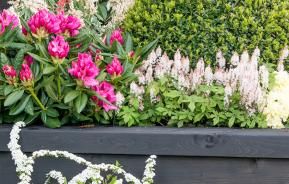
Growing in raised beds
What can raised beds offer to your garden?
Raised beds are a fantastic feature in the garden, allowing you to grow a wider range of plants, boost drainage of the soil and make gardening more accessible along the way. Though raised beds are often used for growing vegetables, there are many uses for them. So, here’s a guide to growing in raised beds and what they can offer in your garden.
Making raised beds
Before you get planting, you’ll need the raised beds in place to get started. Building raised beds from scratch is a worthwhile DIY project for the weekend. Get started by gathering together timber like softwood sleepers, rubber mallet, small trowel, electric drill, spirit level, measuring tape, and bricks, rubble and mortar mix.
Then, it’s time to prepare the ground by digging out strips of turf for the timber to fit.
Lay the timber in position to create a rectangle or square, at the size you want. Use the spirit level to check that the timber is level. Be sure to measure diagonally as well as the length, this will check that the corners are right angles and are even. The rubber mallet can be used to tap the wood so that the adjacent pieces are level and sturdy.
Next, drill through the end timbers at the top and bottom. Screw them into position ready for the next level to be added. The next level of the timbers can be assembled and overlapped on the joints to help achieve a sturdy structure. Before screwing into place, check once again with the spirit level. Add rubble or chippings to the bottom of the bed to aid drainage, then fill the bed up with topsoil and compost like Peat Free Premium All Purpose Compost. Alternatively, there are plenty of raised beds available to buy readymade. You can get styles that are flexible and that can be slotted together to fit the perfect height and size to suit your needs and your garden.
Benefits of growing in raised beds
Raised beds add height and interest to the garden, and depending on the materials used to build, can add a rustic aesthetic or complement a contemporary design. However, it’s not just about what they visually add to the space.
Incorporating raised beds into your garden design allows you to introduce a different soil type to the garden, so you can grow a wider range of plants. If your garden isn’t the perfect fit to grow the plants that you want, having a raised bed means you can easily add the soil type that the plants need. For instance, fill the raised beds with Peat Free Premium Azalea, Camellia & Rhododendron Ericaceous Compost to suit acid-loving plants like heathers, blueberries and rhododendrons.
Not only that, but they can help improve drainage due to the soil being raised above ground level, which can reduce the risk of waterlogging. Although it’s important to keep an eye on them in prolonged periods of drought as they may need more water.
Another huge benefit of having these structures in your garden is that they improve access if you have restricted mobility. They allow gardening to be more accessible because they reduce the need for bending lower. By installing raised beds, they can be made to suit the gardener’s needs, whether they are gardening from a stool, wheelchair, or kneeler.
Planting in raised beds
The wonder of raised beds is that they can be used to grow almost any plant, from fruits and vegetables to perennials and herbs. They can be used as ornamental beds filled with plants that fit your garden style, or they can be used as productive spaces for growing crops. Alternatively, combine the two by creating a bed full of edible ornamentals like pansies and nasturtiums among Swiss chard and purple kale.
A great thing about using raised beds to grow veg is that it allows veg to be sectioned out. This helps when fertilising and adding organic matter because they are added to a concentrated space. As well as helping with crop rotation as it’s clear to see from separate beds compared to one large veg plot. To put this into practice, you need to divide your plot into 4 sections, with a different crop group in each space.
The most important thing is to fill your raised beds with fruit and veg that you like to eat, or ornamentals that you can enjoy. When you pick what you want to grow, be sure to check the amount of space it will need to grow its best so you don’t overcrowd the area which will impact its growth.
Adding raised beds can make your garden so much more productive as well as accessible to keep gardening fun and accessible. By introducing raised beds, it’s an opportunity to grow a range of new plants with the right soil to suit the job.








